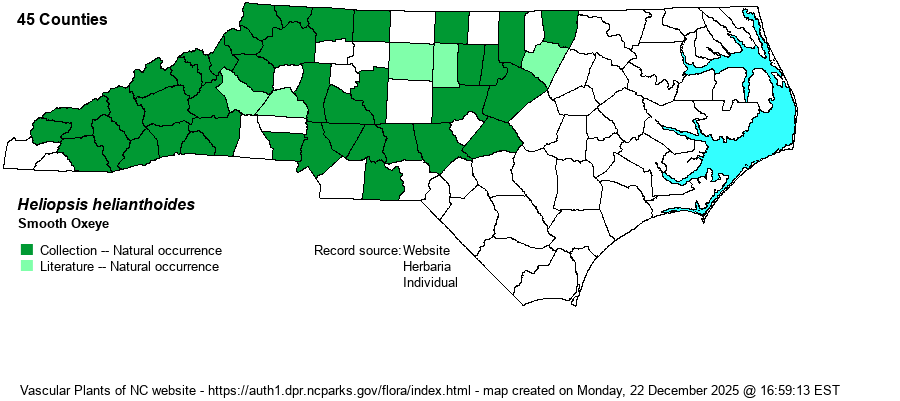| Author | (L.) Sweet | |
| Distribution | Mountains and Piedmont. The existing gaps are not real and will likely be filled with additional collecting.
VT to Ont. and WI, south to GA and LA. | |
| Abundance | Fairly common to frequent in the Mountains; infrequent to locally fairly common in the Piedmont; absent from the Coastal Plain. | |
| Habitat | Moist, irregularly flooded, soils of bottomlands, floodplain forest openings, moist to mesic meadows, roadside ditches. It often occurs in upland sites, such as in glades, powerline clearings, and wooded borders, but there mainly where the soils are of high pH. | |
| Phenology | Flowering and fruiting May to October. | |
| Identification | The genus Heliopsis can be separated from Helianthus by a few technical characters, such as ray florets female and fertile (vs. neuter and infertile) and persistent rays (vs. eventually dropping). Also, the bracts are thick and broad, rather than narrow and acuminate or acute in Helianthus. In the field, Smooth Oxeye grows 2.5-4.5 feet tall, and has opposite, stalked, ovate, toothed, pointy leaves, often with a somewhat truncate leaf base. Stems and leaves are glabrous or nearly so. Flowers are very similar to sunflowers in being several inches across, with yellow rays and yellow disks. If in doubt, look beneath the flower for the broad and thick bracts. Note that the leaf shape is quite variable from plant to plant, and some populations have almost triangular leaves but others closer to lanceolate. Unlike with the Helianthus species, this species often retains the rays for a few months after flowering, often with a few breaking off its distal half over time! | |
| Taxonomic Comments | The variety found in NC is the nominate one.
| |
| Other Common Name(s) | Eastern Oxeye, False-sunflower | |
| State Rank | S4 | |
| Global Rank | G5 | |
| State Status | | |
| US Status | | |
| USACE-agcp | UPL link |
| USACE-emp | FACU link |

